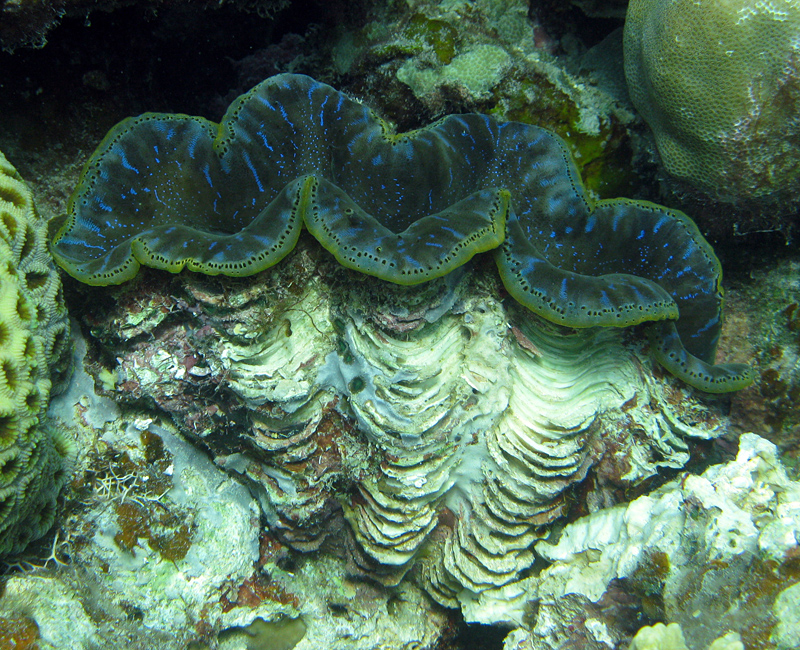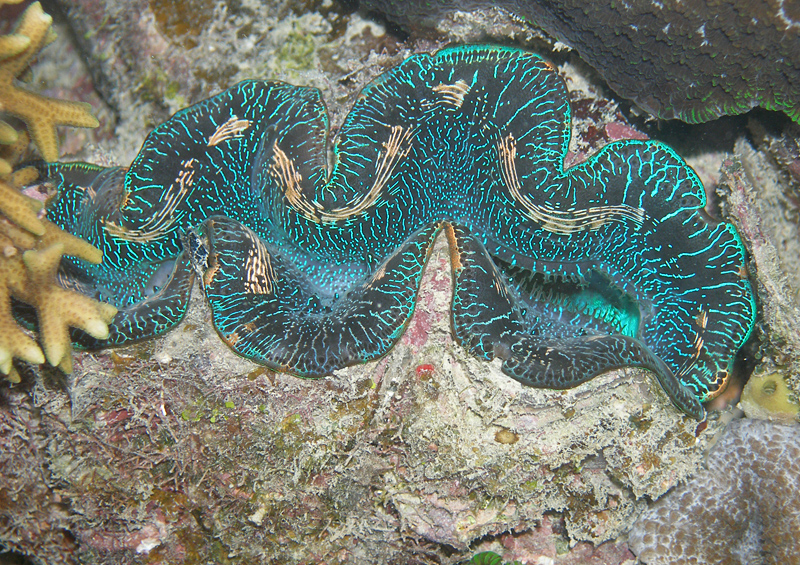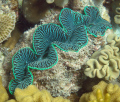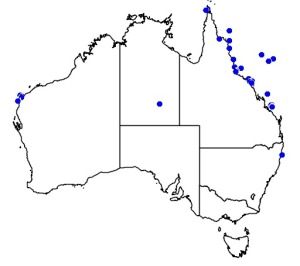
©Andy Lewis: An adult Tridacna maxima at Watson's Bay, showing the asymmetrical shell valves and close-set external scutes
Colours
Distinguishing features
The second smallest and second most abundant of the Giant Clams after Tridacna crocea. This species has shell valves that are elongate on the byssal side, giving an asymmetrical profile when viewed from the side. It has close-set scutes, and the lower part of the shell is usually embedded in the substratum. Mantle colour is highly variable, with blotchy blue, green, and brown patterns all found within local populations. A line of small black ocelli are usually found along the edge of the mantle, and the mantle extends over the edge of the shell when fully extended. Distinguish from other species of Tridacna by the asymmetrical shell and close-set scutes.
Size
- Up to 35 cm (Length of specimen)
Synonyms
Distribution
Distribution and habitat preferences
Found in most habitats, however this species will tolerate high wave action and is often the most abundant Tridacnid on exposed reef fronts. Not generally seen below about 5-6m.
Abundant in shallow habitats around Lizard Island.
Behaviour
Like other Tridacnid clams, this species is a hermaphrodite, with the male testes forming first at about 3 years of age, followed by the female ovaries a year or so later. Tridacnid clams spawn in the warm summer months between October and February, usually during neap tides when water movement is minimal. This allows enough time for adequate mixing of the gametes. Spermatozoa are usually released first, with eggs only released if the animal detects the presence of sperm from a conspecific clam in the water column. Hence, reproduction is most successful when the animals are located in natural clusters. Eggs are only 100µ���������������m (1/10th of a mm) in diameter, and several million are released by each clam during a spawning event. Fertilisation is external, and a trochophore larvae hatches after about 12 hours. A bivalved veliger larvae develops after 48 hours, with a shell length of 160µ���������������m. This stage feeds on plankton and continues to swim in the water column, although it periodically ventures down to assess the conditions on the benthos. The veliger larvae settle permanently to the substratum at about 9 days of age and about 200µ��������m, and the juvenile clams may reach 20-40mm shell length after their first year. Growth accelerates after this point, however mortality in the first few years is very high, with predation by fishes being a major factor.
Tridacnid clams obtain over 95% of their food requirements from the sugars produced by the symbiotic dinoflagellate algae (zooxanthellae) that inhabit the outer mantle tissue. Juvenile clams acquire the zooxanthellae directly from the water column at the time of settlement, and the algae live in tubules that are tertiary extensions of the gut and extend throughout the mantle tissue. Like hard corals, Tridacnid clams may bleach and lose most of their zooxanthellae after high temperature stress.
Web resources
References
- Alder, J. and R.D. Braley (1988). Mass mortalities of giant clams on the Great Barrier Reef (abstract only), ACIAR Monograph Series, 9: 230. LIRS catalog number 910.
- Bishop, D.G. and J.R. Kenrick (1980). Fatty acid composition of symbiotic zooxanthellae in relation to their hosts, Lipids, 15(15): 799-804. LIRS catalog number 43.
- Braley, R.D. (1985). Serotonin-induced spawning in giant clams (Bivalvia:Tridacnidae), Aquaculture, 47: 321-325. LIRS catalog number 179.
- View all references







